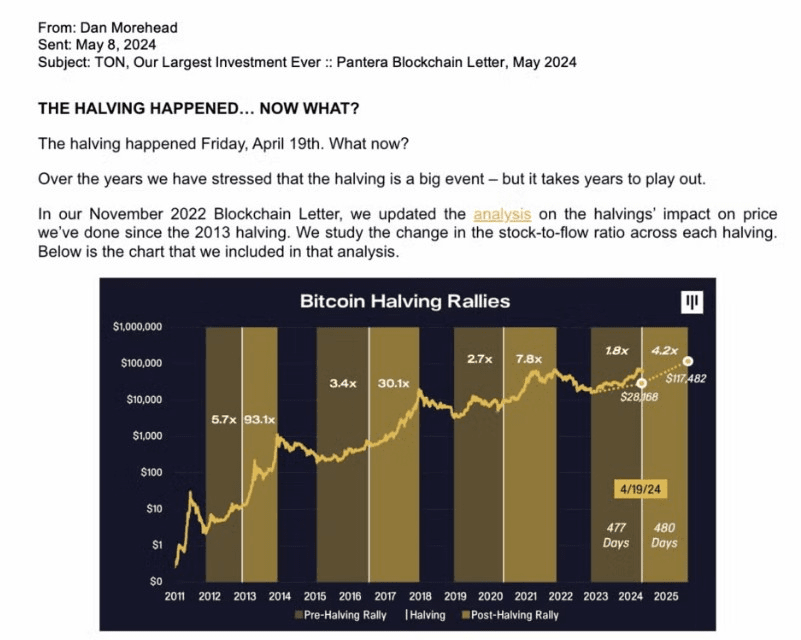
Cryptocurrency venture firm Pantera Capital's insistence on the Bitcoin halving cycle allowed it to predict Bitcoin's price with astonishing accuracy in 2022, highlighting how the asset's supply schedule affects its valuation, even as skepticism about cycle theory continues to grow.
In November 2022, Pantera released a price chart illustrating Bitcoin's price increase after each halving and showing the gradually declining return rates of each four-year cycle. Considering the typical time interval between market bottoms and rebounds after halving, the company predicted that Bitcoin would reach $117,482 on August 11, 2025.
According to data from TradingView, when Pantera made its prediction over two years ago, the price of Bitcoin was around $17,000, close to the cycle low; on August 11 of this year, Bitcoin's closing price reached $118,747, an increase of over 600% from the 2022 low, and only about 1.5% higher than Pantera's predicted price.
 Excerpt from Dan Morehead's May 2024 (Blockchain Letter), quoting Bitcoin price predictions from 2022. Source: Pantera Capital
Excerpt from Dan Morehead's May 2024 (Blockchain Letter), quoting Bitcoin price predictions from 2022. Source: Pantera Capital
It is noteworthy that Pantera seems to have adjusted its predicted price. According to previously compiled articles, the institution's original cycle target price was $148,636, which differs from the $117,482 target price listed in the original text. As of the publication of this article, the trading price of Bitcoin was $119,425.
This wave of price increase highlights the reliability of Bitcoin's four-year price cycle predictions, which are closely related to halving events and typically present a classic pattern of 'post-halving rise, cycle peak, price correction, accumulation of chips.'
Analysts, including Bob Loukas, also use cycle theory to derive Bitcoin's highs and lows. Loukas accurately identified the start of a new four-year cycle in January 2023—less than two months before Bitcoin hit its bottom.
Will institutional adoption change the narrative of Bitcoin cycles?
Each Bitcoin halving cycle brings new rhetoric, claiming 'this time is different' and believing that the four-year cycle pattern will ultimately cease to exist.
Undeniably, the viewpoint that Bitcoin's cyclical momentum will be weakened has its merits: Bitcoin has never been so institutionalized, with ETFs and companies collectively holding millions of Bitcoins.
Since January 2024, the U.S. Bitcoin spot ETF has set the record for the most successful ETF launch in history. According to Bitbo data, ETFs currently hold 7.1% of Bitcoin's total supply, approximately 1.491 million BTC, while public and private companies hold another 1.36 million BTC.
Writer and investor Jason Williams noted that the rise of Bitcoin financial strategy companies is one of the reasons he believes 'the four-year Bitcoin cycle has ended.'
 Source: Jason Williams
Source: Jason Williams
Bitcoin advocate Pierre Rochard also agrees with this view, pointing out: 'The halving has little impact on trading volume because 95% of Bitcoin has already been mined. The market supply mainly comes from acquiring early holders' chips, while the demand comes from retail investors, ETPs included in wealth management platforms, and financial strategy companies.'
However, some experts believe that the Bitcoin halving cycle will still have an impact on price trends. Seamus Rocca, CEO of the long-established crypto-friendly bank Xapo Bank, pointed out in July this year that this cyclical pattern still exists, and the market may still enter a long-term bear market without needing to wait for a 'catastrophic' event to trigger it.
Reference source
Related report: (21Shares Report: What's Different About the Fourth Bitcoin Halving?)
Source

